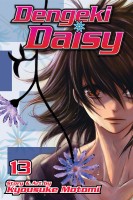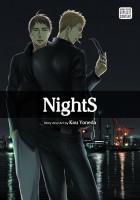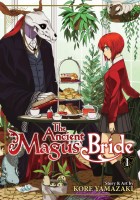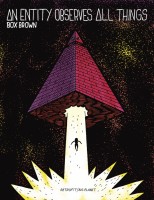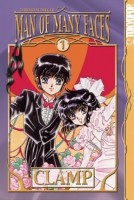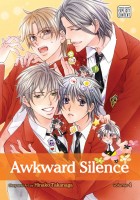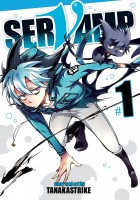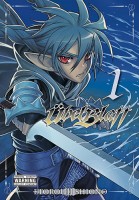My News and Reviews
Two in-depth reviews were posted at Experiments in Manga last week. The first took a look at Mushishi, Volume 4 by Yuki Urushibara. The review is part of my monthly horror manga review project; next month I’ll be bouncing back to Setona Mizushiro’s After School Nightmare. Mushishi continues to be one of my favorite manga series. The second review was of A Sky Longing for Memories: The Art of Makoto Shinkai, the most recent artbook to be released by Vertical. It’s a gorgeous volume to simply look at, but I also learned a little about art design and digital illustration while reading it, too. Also of note, over at Organization Anti-Social Geniuses, I and six other manga and anime enthusiasts weighed in on the question “What Was the Biggest Announcement at Anime Expo/SDCC?”
There were a few other manga-related posts at OASG last week, too, including some great tips on getting manga for cheap, advice from manga letterers, and an interview with Kodansha’s Ben Applegate from San Diego Comic-Con. A couple of other convention-related articles that I came across: Brigid Alverson talked to Tokyopop’s Stu Levy and Deb Aoki summarizes some of the recent manga news. Also, the audio recordings of some of the SDCC panels, including the Best and Worst Manga panel, have been posted.
In licensing news, Seven Seas announced The Other Side of Secret manga series by Hideaki Yoshikawa. Seven Seas will also be releasing a newly-illustrated omnibus of L. Frank Baum’s The Wonderful Wizard of Oz & The Marvelous Land of Oz. (This will be similar to Seven Seas’ edition of Lewis Carroll’s Alice’s Adventures in Wonderland and Through the Looking-Glass which was quite charming.) Finally, a couple of interesting reads I happened upon: Léopold Dahan wrote about studying the magazine Garo and Kevin Frane discussed gender in Quantum Devil Saga: Avatar Tuner. (Frane is the translator of the series in English, and I really enjoyed the first volume, but I’m looking forward to the following volumes even more now.)
Quick Takes
 After I Win by Kaname Itsuki. Out of all the boys’ love manga that I’ve so far read, I think After I Win is the one that is the quickest to reach the all-important love confession. Only three pages into the manga and the leads—the beautiful Hiyori and his underclassman and roommate Kasumi—have admitted their feelings for each other. Granted, it takes most of the rest of the volume for them each to realize that the other young man actually meant what he said. After I Win is probably also the boys’ love manga with the most masturbation scenes that I’ve come across. (In the afterword, Itsuki mentions that it was her intention to feature at least one such scene in every chapter.) Hiyori and Kasumi spend so much time getting it on on their own rather than getting it on together for two main reasons: the aforementioned confusion regarding how seriously they should take each other’s confession, and the fact that Hiyori gets so nervous with anticipation and excitement that he tends to get nauseous. But even considering this, and despite his angelic appearance, Hiyori is very dirty-minded and looks forward to the opportunity to cement his relationship with Kasumi physically. After I Win, perhaps surprisingly, is actually pretty cute.
After I Win by Kaname Itsuki. Out of all the boys’ love manga that I’ve so far read, I think After I Win is the one that is the quickest to reach the all-important love confession. Only three pages into the manga and the leads—the beautiful Hiyori and his underclassman and roommate Kasumi—have admitted their feelings for each other. Granted, it takes most of the rest of the volume for them each to realize that the other young man actually meant what he said. After I Win is probably also the boys’ love manga with the most masturbation scenes that I’ve come across. (In the afterword, Itsuki mentions that it was her intention to feature at least one such scene in every chapter.) Hiyori and Kasumi spend so much time getting it on on their own rather than getting it on together for two main reasons: the aforementioned confusion regarding how seriously they should take each other’s confession, and the fact that Hiyori gets so nervous with anticipation and excitement that he tends to get nauseous. But even considering this, and despite his angelic appearance, Hiyori is very dirty-minded and looks forward to the opportunity to cement his relationship with Kasumi physically. After I Win, perhaps surprisingly, is actually pretty cute.
 Alice in the Country of Hearts: My Fanatic Rabbit, Volumes 1-2 by Psyche Delico. After reading and enjoying the first Alice in the Country of Hearts manga series, I asked fellow enthusiasts to recommend which among the multitude of Alice manga I should follow-up with. My Fanatic Rabbit wasn’t mentioned a single time. So why did I tackle it next? Mostly because Psyche Delico was involved. (I loved her other manga released in English, Love Full of Scars.) My Fanatic Rabbit is more or less a retelling of Alice in the Country of Hearts, except that Alice has decided to stay with the Hatter mafia rather than Julius, ultimately falling in love with the March Hare. There are some cute romantic parts scattered throughout the series, especially towards the end, as well as some genuinely funny moments, but overall the manga really isn’t especially strong. It doesn’t stand well on its own and those who have read the first series won’t find much new, either. Maybe in part because it’s a shorter series, neither the characters nor the world have much of chance to develop and simply must be taken as is. My Fanatic Rabbit will likely appeal most to those who want to see Elliot and Alice together.
Alice in the Country of Hearts: My Fanatic Rabbit, Volumes 1-2 by Psyche Delico. After reading and enjoying the first Alice in the Country of Hearts manga series, I asked fellow enthusiasts to recommend which among the multitude of Alice manga I should follow-up with. My Fanatic Rabbit wasn’t mentioned a single time. So why did I tackle it next? Mostly because Psyche Delico was involved. (I loved her other manga released in English, Love Full of Scars.) My Fanatic Rabbit is more or less a retelling of Alice in the Country of Hearts, except that Alice has decided to stay with the Hatter mafia rather than Julius, ultimately falling in love with the March Hare. There are some cute romantic parts scattered throughout the series, especially towards the end, as well as some genuinely funny moments, but overall the manga really isn’t especially strong. It doesn’t stand well on its own and those who have read the first series won’t find much new, either. Maybe in part because it’s a shorter series, neither the characters nor the world have much of chance to develop and simply must be taken as is. My Fanatic Rabbit will likely appeal most to those who want to see Elliot and Alice together.
 Aquarion Evol, Volumes 1-3 written by Shoji Kawamori, illustrated by Aogiri. Despite taking place twelve thousand years after Genesis of Aquarion, its sequel Aquarion Evol doesn’t make much sense at all to those who aren’t already familiar with the franchise. At least that’s the case for the ongoing manga series; perhaps the anime does a better job of initiating newcomers. Having seen neither of the anime series, I can only say that the story of the Aquarion Evol is a mess and nearly impenetrable at first. By the third volume things begin to be explained a little more coherently, but the manga seems to be taking a lot of shortcuts with the plot and character development. Probably because of my confusion, I generally wasn’t overly impressed with the Aquarion Evol, but there were still some things that I liked about it. The various supernatural powers are interesting (there’s even a music-based one!) as are the somewhat bizarre gender dynamics and curious sexual overtones. The artwork is attractive, too, with exciting action sequences and nice character designs. The mecha are difficult to tell apart at first glance, though. I wonder if I might actually enjoy the Aquarion Evol anime, but I find the manga to be frustrating.
Aquarion Evol, Volumes 1-3 written by Shoji Kawamori, illustrated by Aogiri. Despite taking place twelve thousand years after Genesis of Aquarion, its sequel Aquarion Evol doesn’t make much sense at all to those who aren’t already familiar with the franchise. At least that’s the case for the ongoing manga series; perhaps the anime does a better job of initiating newcomers. Having seen neither of the anime series, I can only say that the story of the Aquarion Evol is a mess and nearly impenetrable at first. By the third volume things begin to be explained a little more coherently, but the manga seems to be taking a lot of shortcuts with the plot and character development. Probably because of my confusion, I generally wasn’t overly impressed with the Aquarion Evol, but there were still some things that I liked about it. The various supernatural powers are interesting (there’s even a music-based one!) as are the somewhat bizarre gender dynamics and curious sexual overtones. The artwork is attractive, too, with exciting action sequences and nice character designs. The mecha are difficult to tell apart at first glance, though. I wonder if I might actually enjoy the Aquarion Evol anime, but I find the manga to be frustrating.
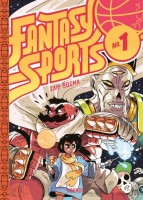 Fantasy Sports, Volume 1 by Sam Bosma. Before stumbling upon Fantasy Sports, I hadn’t previously read any of Bosma’s work. I definitely want to read more now because Fantasy Sports was fantastic. It apparently started out as a self-published, black-and-white comic called Fantasy Basketball, but it was later expanded and colored for release by Nobrow and made the first installment in an ongoing series. I absolutely loved the comic and can’t wait to read future volumes of Fantasy Sports. The story follows Wiz, a young magic user and intern at The United and Ancient Order of Mages. Her mentor in the guild is Mug, a hulk of a man who usually solves his problems through brute strength and who doesn’t know a thing about magic. They don’t really get along very well, making their job raiding and searching for treasure even more difficult. During their most recent expedition, they encounter an ancient mummy who they must defeat in a game of basketball if they hope to escape with the fortune and their lives intact. It’s a slim volume, but with great art, great colors, and great characters, not to mention just enough silliness and adventure, the first volume of Fantasy Sports is a tremendous amount of fun.
Fantasy Sports, Volume 1 by Sam Bosma. Before stumbling upon Fantasy Sports, I hadn’t previously read any of Bosma’s work. I definitely want to read more now because Fantasy Sports was fantastic. It apparently started out as a self-published, black-and-white comic called Fantasy Basketball, but it was later expanded and colored for release by Nobrow and made the first installment in an ongoing series. I absolutely loved the comic and can’t wait to read future volumes of Fantasy Sports. The story follows Wiz, a young magic user and intern at The United and Ancient Order of Mages. Her mentor in the guild is Mug, a hulk of a man who usually solves his problems through brute strength and who doesn’t know a thing about magic. They don’t really get along very well, making their job raiding and searching for treasure even more difficult. During their most recent expedition, they encounter an ancient mummy who they must defeat in a game of basketball if they hope to escape with the fortune and their lives intact. It’s a slim volume, but with great art, great colors, and great characters, not to mention just enough silliness and adventure, the first volume of Fantasy Sports is a tremendous amount of fun.


